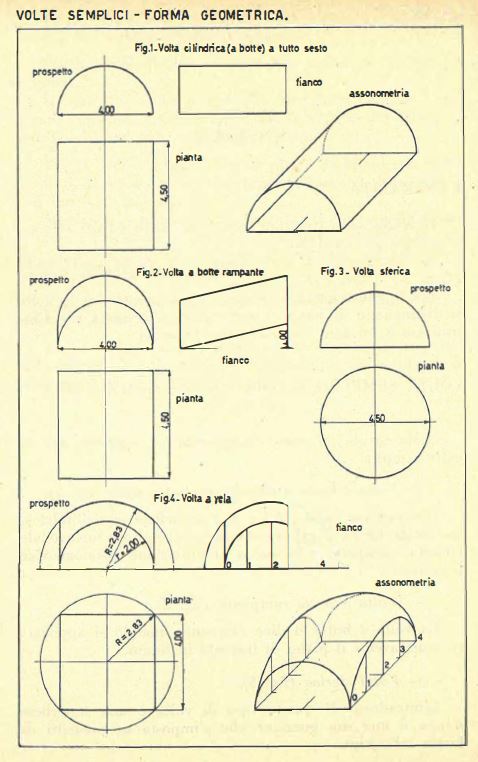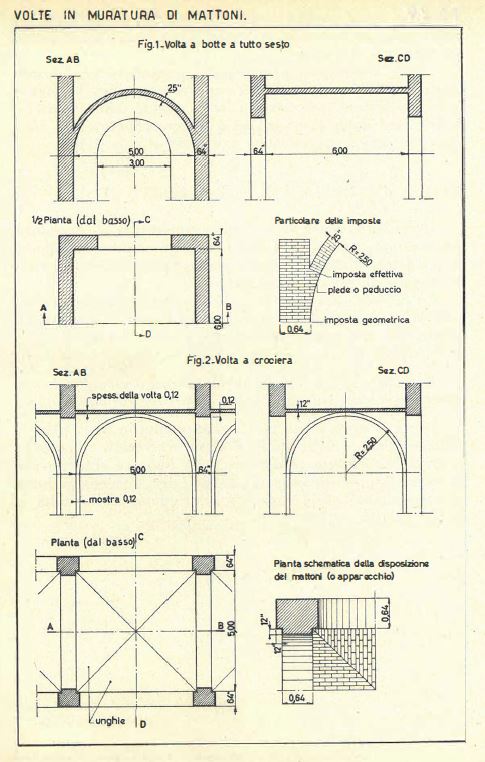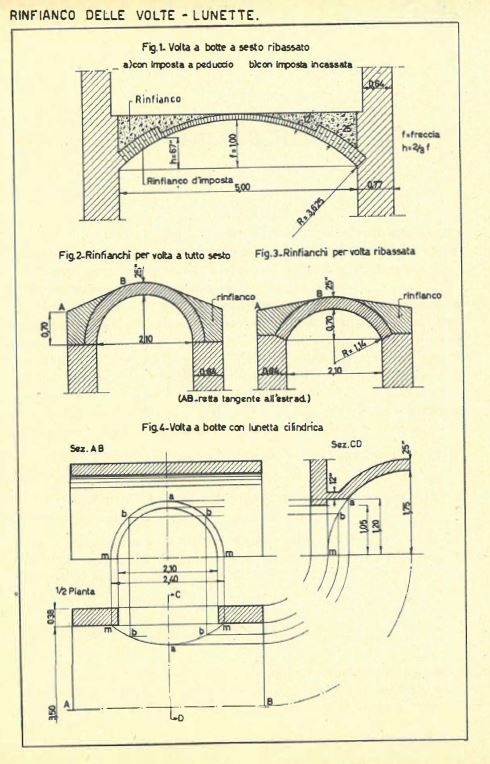LE VOLTE
The vaults
- 02 Apr 2023
Le volte sono strutture curve che negli edifici servono a coprire gli ambienti.
Per quanto riguarda la loro forma geometrica le volte si distinguono in semplici e composte a seconda che l’intradosso sia formato da una o più superfici .
VOLTE SEMPLICI E LORO FORMA GEOMETRICA
I tipi di volte semplici sono i seguenti:
– Volta a botte o cilindrica a tutto sesto (fig. 1).
L’intradosso della volta è una superficie semicilindrica, che nella figura è rappresentata in proiezione ortogonale (pianta, prospetto e fianco) e in proiezione assonometrica ( cavaliera).
– Volta a botte rampante (fig. 2).
La volta a botte si dice rampante quando si appoggia su muri aventi il piano di imposta inclinato.
– Volta sferica (fig. 3).
L’intradosso di questo tipo di volta è una superficie sferica o una sua porzione che s’imposta su piedritti di forma cilindrica.
– Volta a vela su pianta quadrata (fig. 4).
Questa volta deriva da una volta sferica. Infatti, se alla circonferenza di base di una volta sferica s’inscrive un quadrato e per i lati di questo si conducono dei piani verticali sino a tagliare la volta, la porzione di questa che rimane sopra il quadrato è appunto la volta a vela.

VOLTE COMPOSTE E LORO FORMA GEOMETRICA
Nel seguito sono rappresentati in proiezione ortogonale e in proiezione assonometrica (cavaliera) i seguenti tipi di volte composte:
– Volta a padiglione su pianta quadrata (fig. 1).
La superficie d’intradosso è formata dall’unione di quattro fusi cilindrici uguali.
– Volta a botte con testa di padiglione ( fig. 2).
Risulta formata dall’insieme di una volta a botte, impostata sui lati più lunghi del vano da coprire e di due fusi cilindrici, impostati sui. lati più corti.
– Volta a crociera su pianta quadrata ( fig. 3).
La superficie d’intradosso è formata dall’unione di quattro unghie cilindriche uguali.

VOLTE IN MURATURA DI MATTONI
Le volte in muratura di mattoni sono le più usate negli edifici. Il loro spessore supera raramente le due teste di mattone e spesso, per ambienti di luce inferiore a 5 m., si impiegano volte di mattoni in foglio (o di quarto).
La fig.1 si riferisce ad una volta a botte tutto sesto su pianta rettangolare di m. 5 x 6, rappresentata in metà pianta e sezione trasversale e longitudinale. La figura mostra anche un particolare dell’appoggio della volta su apposito peduccio d’imposta, anche questo in muratura di mattoni.
La fig. 2 esemplifica una volta a crociera su pianta quadrata di m. 5 x 5. La figura rappresenta, oltre la pianta e le due sezioni trasversale e longitudinale della volta, un particolare della disposizione o apparecchiatura dei mattoni (a corsi perpendicolari agli archi d’imposta).

RINFIANCO DELLE VOLTE -LUNETTE
II rinfianco delle volte è un riempimento di muratura (in mattoni, calcestruzzo, ecc.), eseguito sopra l’estradosso fino a formare una superficie, per lo più piana, orizzontale e tangente all’estradosso stesso).
Le lunette sono piccole volte eseguite lateralmente ad una volta principale; possono avere carattere puramente decorativo, ma usualmente servono a coprire vani di porte e finestre.
Le figure 1, 2 e 3 rappresentano in sezione traversale tre volte con i rispettivi rinfianchi.
La fig. 4 della stessa tavola rappresenta in metà pianta, sezione longitudinale e metà sezione trasversale, una volta a botte con lunetta cilindrica. Nella figura è chiaramente indicato il procedimento geometrico per ottenere la linea d’intersezione fra le superfici d’intradosso della volta e della lunetta.

Fonti
“MURATORI – disegno professionale” – Serie III – N.10 – Ed. I.N.A.P.L.I. – 1966
 Arch. Anselmo Santilli – ZEDPROGETTI srl
Arch. Anselmo Santilli – ZEDPROGETTI srl
The vaults are curved structures that in buildings serve to cover the rooms.
As far as their geometric shape is concerned, the vaults can be divided into simple and composed according to whether the intrados is formed by one or more surfaces.SIMPLE VAULTS AND THEIR GEOMETRIC SHAPE
The simple types of times are as follows:
– Round barrel vault or cylindrical round vault (fig. 1).
The intrados of the vault is a semi-cylindrical surface, which in the figure is represented in orthogonal projection (plan, elevation and side) and in axonometric projection (knight).
– Rampant barrel vault (fig. 2).
The barrel vault is called rampant when it rests on walls with an inclined shutter plane.
– Spherical vault (fig. 3).
The intrados of this type of vault is a spherical surface or a portion of it that stands on cylindrically shaped pedestals.
– Sail vault on a square plan (fig. 4).
This time it comes from a spherical vault. In fact, if a square is inscribed on the base circumference of a spherical vault and the sides of the square are led in vertical planes until the vault is cut, the portion of this that remains above the square is the sail vault.COMPOSED VAULTS AND THEIR GEOMETRIC SHAPE
In the following are represented in orthogonal projection and in axonometric projection (knight) the following types of times composed:
– Pavilion vault on a square plan (fig. 1).
The intrados surface is formed by the union of four equal cylindrical spindles.
– Barrel vault with pavilion head (fig. 2).
It is formed by the combination of a barrel vault, set on the longer sides of the space to be covered and two cylindrical spindles, set on the shorter sides.
– Cross vault on a square plan ( fig. 3).
The intrados surface is formed by the union of four equal cylindrical nails.MASONRY BRICK VAULTS
Masonry brick vaults are the most used in buildings. Their thickness rarely exceeds two brick heads and often, for rooms with a span of less than 5 m., sheet (or quarter) brick vaults are used.
Fig.1 refers to a round barrel vault on a rectangular plan of 5 x 6 m., represented in half plan and cross section and longitudinal. The figure also shows a detail of the support of the vault on a special corbel, also in brick masonry.
Fig. 2 exemplifies a cross vault on a square plan of 5 x 5 m. The figure represents, in addition to the plan and the two transversal and longitudinal sections of the vault, a detail of the arrangement or equipment of the bricks (in courses perpendicular to the impost arches).VAULTS -LUNETTE
The vaults are filled with masonry (made of bricks, concrete, etc.), which is carried out over the extrados to form a surface, mostly flat, horizontal and tangent to the extrados itself).
The lunettes are small vaults executed laterally to a main vault; they can be purely decorative, but usually serve to cover door and window compartments.
Figures 1, 2 and 3 represent a cross section three times with their respective flanks.
Fig. 4 of the same table represents in half plan, longitudinal section and half cross section, a barrel vault with cylindrical bezel. The figure clearly shows the geometrical procedure to obtain the line of intersection between the intrados surfaces of the vault and the bezel.

